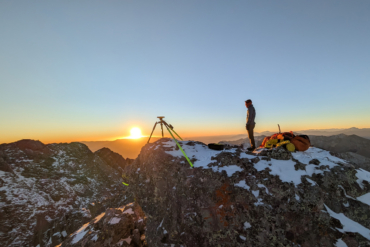‘This spring, he realized he didn’t want to go back. He couldn’t justify it for his children, his wife, and also himself to a certain degree. That’s when I knew I was going to go back by myself.’ — David Lama on climbing Lunag Ri without Conrad Anker
On October 25, David Lama climbed Lunag Ri by himself, three years after his first attempt. The 28-year-old Austrian alpinist has made four total attempts, including the first two with Conrad Anker.
Lunag Ri is a gem of mountaineering, standing 22,660 feet tall on the border of Nepal and Tibet. Composed of a mixture of snow, ice, and rock, it demands very technical rock climbing ability and skill. Before Lama, nobody had made it to the top.
Normally, mountains of this stature demand a team or partner to climb. But Lama made the unique decision to climb alone.
Over the course of three brutally cold days, Lama made his own bivouacs, rigged his own self-belays, and pushed to the summit. And he made it to the top and back down without any major complications.
We spoke with Lama, an athlete with The North Face, to learn what drove him to climb Lunag Ri solo and what it took to make it to the top.

Lunag Ri Climb: David Lama’s History With Iconic Peak
It’s rare for such a striking mountain in the Himalayas to go unclimbed for this long. In fact, the Nepalese government only began to issue climbing permits over the past few years.
Lama became fixated on the mountain three years ago and made four attempts since. His first two were with Anker, one year between each attempt.
The duo’s first trek brought them 300 meters from the summit. And during the beginning of their second attempt last year, Anker experienced a heart attack.
Shortly after Anker departed to Kathmandu and was deemed stable, Lama made a spur-of-the-moment decision to climb Lunag Ri. It was not an easy decision for Lama to make, as seen in the documentary about the attempt:
In that solo push, Lama made it within 250 meters of the summit. Ultimately, however, he was forced to bail before reaching the top.
Summit Push: Lama Climbs Lunag Ri
This fall, Lama returned for his fourth attempt at the summit. And this time, he made the decision well ahead of time to go solo.
“There were a bunch of other alpinists that asked to join me,” said Lama. “I told them all I feel the need to go back by myself because I wanted to finish it off for Conrad and me in the most beautiful way that I could imagine.”

And because he knew ahead of time he was going to climb solo, he spent half a year preparing.
“I spent a lot of time testing my self-belaying techniques, testing all of my gear, really finding the right strategy to make it as likely as possible,” Lama said. “Whenever you self-belay, you basically have to place an anchor at the bottom, climb up, fix the rope again, place an anchor at the top, then descend along the rope again to take down the lower anchor, then climb up the rope again.”
Self-belaying is much more time-intensive, as climbers essentially travel the length of each self-belayed pitch three times.
In October, Lama settled into base camp for 10 days, spending time preparing and acclimatizing.

When he was ready, he started climbing Lunag Ri at 2:00 a.m. for optimal ice climbing conditions. Lama explained that rock and ice start to fall when the sun enters the valley.
He set up the tent at his first bivvy site and spent 24 hours there. Winds up to 50 mph and temperatures down to -22 degrees F kept him from climbing.
At 6:00 a.m. the next day, he continued up the face toward the left ridge. He made it to the headwall for his second bivvy, marking a new high point on the route.
This was where the climb got tricky. Because the headwall wasn’t visible from basecamp or any part of the route, Lama had to climb purely on intuition and what was immediately in front of him. After a series of ice slabs and gulleys, Lama eventually made it to the summit.
In all, he didn’t end up belaying for most of the route. With a very light pack, he belayed nothing on the first day, about 50 meters on the second, and 100 meters on the third.

Why Climb Solo? Lama Explains Motivation
Lama did not make it easy on himself by climbing Lunag Ri solo, but that wasn’t entirely the point. If he wasn’t going to climb with Anker, he would climb solo.
“My decision was how can I bring this to an end in the most beautiful way,” Lama explained. And to him, climbing Lunag Ri in a beautiful manner didn’t involve someone else who hadn’t shared his previous experiences as Anker did. To him, it was less about whether he reached the summit than how.
He went on to explain his motivation for the solo climb in detail:
“I knew that I was going to make it easier if I climbed it with someone else. A lot of things become harder when climbing by yourself. One of the biggest challenges is having the self-confidence that your plan is going to work out. You have to build it up and keep it up even when you’re tired.
“Whenever you have your doubts, and you’re climbing with a partner, there’s someone there to share your thoughts with — even if you don’t talk with your partner about your doubts or what bothers you or what worries you. If your partner keeps them moving on, you know that he has the confidence, and that builds up your confidence and belief in the project.”

David Lama’s Future Climbing Style: Solo or Partner
Without question, cutting-edge solo climbing has surged into popularity in the past few years. From Alex Honnold’s free solo of El Capitan to Kilian Jornet summiting Everest twice in one week to the late Ueli Steck’s records in the European Alps, solo climbing has drifted to the mainstream. But Lama doesn’t plan to become a soloist.
“It’s not my goal to become a solo climber. It’s something that I chose for this project,” he said. “In no way would I ever say that climbing by yourself is worth more than climbing with a partner.”
Watch his remarkable video of the ascent below:
Something tells us whatever Lama decides to do, he will continue to push the limits of alpinism. But for now, he’s already continuing to climb big mountains.
The young alpinist was so thrilled upon his climb of Lunag Ri that upon his return to base camp, he embarked on a three-day trek to climb “nearby” 21,000-foot Cholatse. As if Lunag Ri wasn’t enough!







